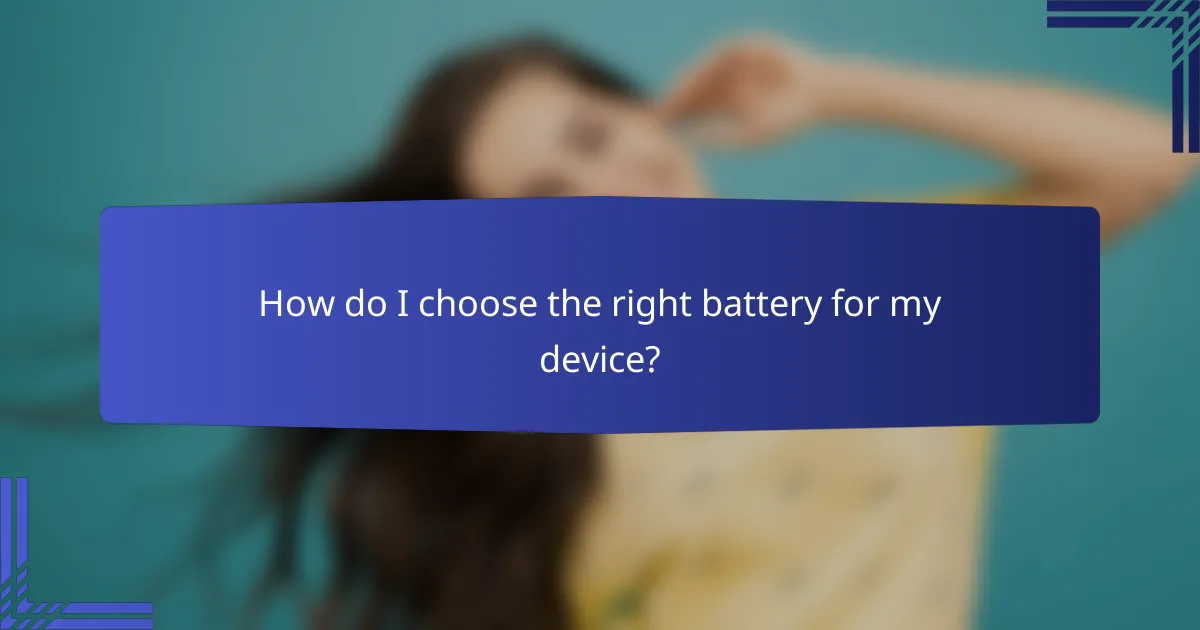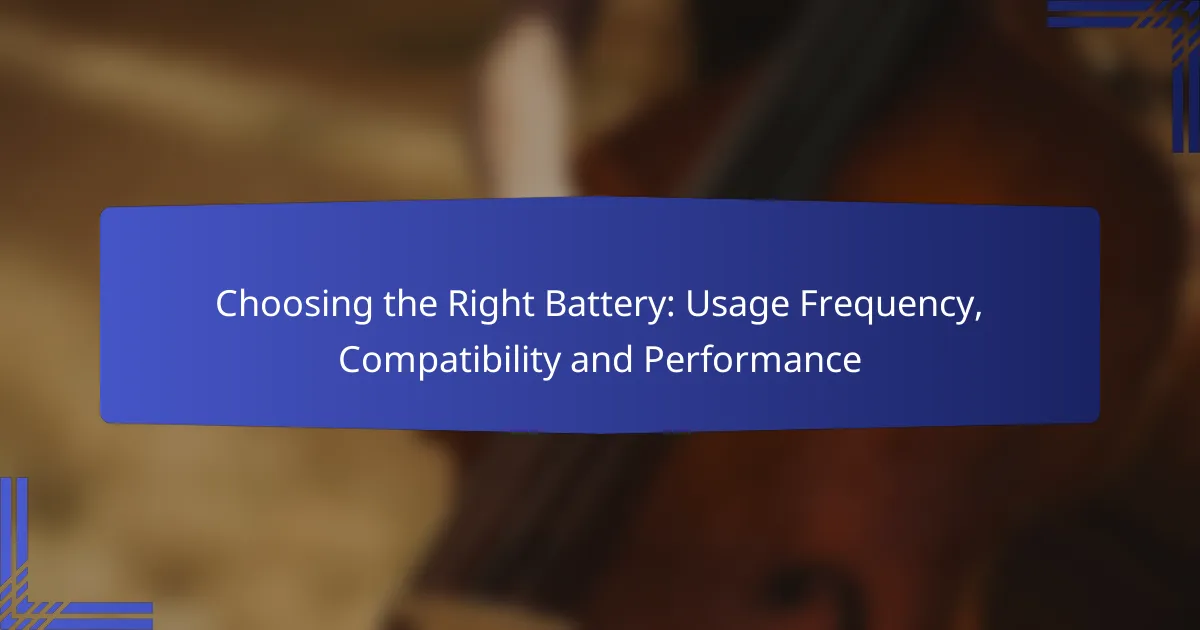Choosing the right battery involves understanding your usage frequency, compatibility with your device, and performance characteristics. Different battery types, such as lithium-ion and alkaline, offer unique benefits tailored to specific needs. By considering your device’s specifications and the factors affecting battery performance, you can select a battery that ensures optimal efficiency and longevity.

What are the best batteries for frequent use?
The best batteries for frequent use typically include lithium-ion, nickel-metal hydride, and alkaline options. Each type has unique characteristics that cater to different needs, such as rechargeability, energy density, and cost-effectiveness.
Lithium-ion batteries
Lithium-ion batteries are known for their high energy density and long cycle life, making them ideal for devices that require frequent recharging. They can maintain performance over hundreds of charge cycles, which is beneficial for gadgets like smartphones and laptops.
However, they can be more expensive upfront compared to other types. It’s essential to ensure compatibility with your device, as improper use can lead to safety issues.
Nickel-metal hydride batteries
Nickel-metal hydride (NiMH) batteries are a popular choice for rechargeable applications, especially in household electronics like digital cameras and remote controls. They offer a good balance between capacity and cost, typically providing a moderate energy density.
While they don’t hold a charge as long as lithium-ion batteries, they are generally more affordable and environmentally friendly. Regular charging is recommended to maintain their performance and lifespan.
Alkaline batteries
Alkaline batteries are widely available and suitable for devices with low to moderate power demands, such as toys and flashlights. They are non-rechargeable and often less expensive than rechargeable options.
While they have a decent shelf life, their performance can degrade quickly in high-drain devices. It’s advisable to choose alkaline batteries for occasional use rather than frequent, high-energy applications.
Rechargeable options
Rechargeable batteries, including lithium-ion and NiMH, are cost-effective for frequent use since they can be reused multiple times. They reduce waste and are often more economical in the long run, especially for high-drain devices.
When selecting rechargeable options, consider the charging time and cycle life. Some models can be charged in under an hour, while others may take several hours.
Performance metrics
When evaluating battery performance, key metrics include capacity (measured in milliampere-hours, or mAh), voltage, and discharge rates. Higher capacity generally means longer usage times, but it’s crucial to match the battery specifications with your device’s requirements.
Additionally, consider the temperature range and self-discharge rates, as these factors can affect battery longevity and efficiency. Regularly check for updates on battery technology to ensure you’re using the best option for your needs.

How to determine battery compatibility?
To determine battery compatibility, you need to consider the specific requirements of your device, including its specifications, voltage needs, and physical dimensions. Ensuring that the battery matches these criteria will help maintain optimal performance and prevent potential damage.
Device specifications
Device specifications outline the type of battery required, often listed in the user manual or on the manufacturer’s website. Check for the model number and any specific battery type mentioned, such as lithium-ion or nickel-metal hydride. Using the correct type is crucial for safe operation and efficiency.
Additionally, some devices may have unique features that require proprietary batteries. Always verify that the replacement battery matches the original specifications to avoid compatibility issues.
Voltage requirements
Voltage is a critical factor in battery compatibility. Most devices require batteries with a specific voltage rating, typically ranging from 1.2V to 24V. Using a battery with a voltage significantly higher or lower than required can lead to malfunction or damage.
To find the correct voltage, look for markings on the device or consult the user manual. If you’re unsure, it’s safer to choose a battery from the same manufacturer or one that is explicitly labeled as compatible.
Physical dimensions
Physical dimensions of the battery must match the space available in the device. Measure the height, width, and depth of the battery compartment to ensure a proper fit. Batteries that are too large may not fit, while those that are too small can lead to poor connections.
It’s advisable to use batteries that are designed for your specific device model. If you’re considering third-party options, check reviews and specifications to confirm that they meet the necessary size requirements.

What factors affect battery performance?
Battery performance is influenced by several key factors including temperature sensitivity, charge cycles, and discharge rates. Understanding these elements can help you choose the right battery for your needs and maximize its efficiency.
Temperature sensitivity
Temperature sensitivity refers to how a battery’s performance can change with varying temperatures. Most batteries operate optimally within a specific temperature range, typically between 20°C to 25°C (68°F to 77°F). Extreme heat can lead to faster degradation, while cold temperatures can reduce capacity and efficiency.
For example, lithium-ion batteries may lose up to 20% of their capacity at temperatures below 0°C (32°F). It’s crucial to store and use batteries within their recommended temperature ranges to ensure longevity and reliability.
Charge cycles
Charge cycles indicate how many times a battery can be charged and discharged before its capacity significantly diminishes. A typical lithium-ion battery can endure hundreds to over a thousand charge cycles, depending on usage and care. Each cycle slightly reduces the battery’s overall capacity.
To extend battery life, avoid deep discharges and frequent full charges. Instead, aim to keep the battery between 20% and 80% charged whenever possible, which can help maximize the number of effective charge cycles.
Discharge rates
Discharge rates measure how quickly a battery can release its stored energy. High discharge rates can be beneficial for devices requiring quick bursts of power, but they may also lead to faster depletion of the battery. Understanding the discharge rate is essential for matching a battery to its intended application.
For instance, batteries designed for high-drain devices like power tools or gaming controllers typically have higher discharge rates compared to those used in low-drain devices like remote controls. Always check the specifications to ensure compatibility with your device’s power demands.

How do I choose the right battery for my device?
Choosing the right battery for your device involves considering its usage frequency, device type, and energy needs. By assessing these factors, you can select a battery that ensures optimal performance and longevity.
Usage frequency
Your device’s usage frequency significantly impacts the type of battery you should choose. For devices used daily, such as smartphones or laptops, opt for rechargeable batteries that can withstand frequent cycles. Conversely, for devices used sporadically, like remote controls or smoke detectors, disposable batteries may be more practical.
Consider how often you will need to replace or recharge the battery. Regular use may warrant a higher-capacity battery, while infrequent use can allow for lower-capacity options that are more cost-effective.
Device type
The type of device plays a crucial role in battery selection. Different devices have varying power requirements and compatibility needs. For example, high-drain devices like digital cameras require batteries that can deliver a consistent high current, while low-drain devices like clocks can function well with standard alkaline batteries.
Always check the manufacturer’s specifications for recommended battery types. Using the wrong battery can lead to poor performance or even damage to the device.
Energy needs
Understanding the energy needs of your device is essential for selecting the right battery. Devices with higher energy demands, such as gaming consoles or power tools, typically require lithium-ion or nickel-metal hydride batteries, which offer better performance and longer life.
For lower energy needs, such as remote controls or LED flashlights, standard alkaline batteries may suffice. Assess the voltage and capacity requirements to ensure compatibility and optimal functionality.

What are the shipping and return policies for batteries?
Shipping and return policies for batteries vary by retailer but generally include specific guidelines for delivery options and conditions for returns. Understanding these policies can help you make informed purchasing decisions and avoid potential issues.
Shipping options
Most retailers offer a range of shipping options for batteries, including standard, expedited, and same-day delivery in some areas. Standard shipping typically takes between three to seven business days, while expedited options can reduce delivery time to one or two days.
When ordering batteries, check if the retailer provides free shipping on orders above a certain amount, which can save you money. Additionally, some companies may have restrictions on shipping batteries due to regulations, so confirm that your chosen option is available for your location.
Return conditions
Return conditions for batteries often require that the product be unopened and in its original packaging. Many retailers allow returns within a specific timeframe, usually ranging from 14 to 30 days after purchase, but this can vary, so always verify the policy before buying.
Some retailers may charge a restocking fee for returned batteries, especially if they are opened. To avoid issues, keep your receipt and follow the return instructions provided by the retailer, which may include shipping the item back or returning it to a physical store.
